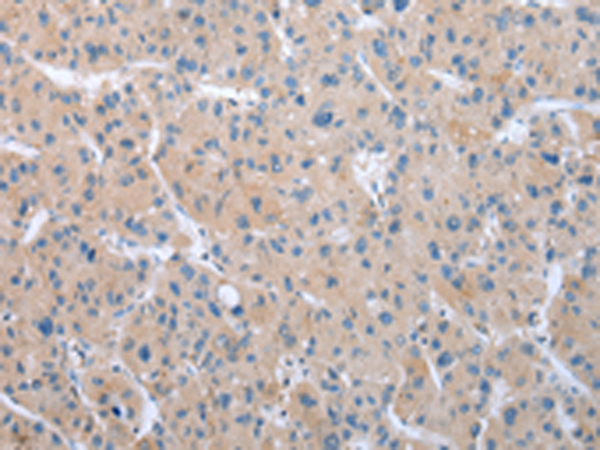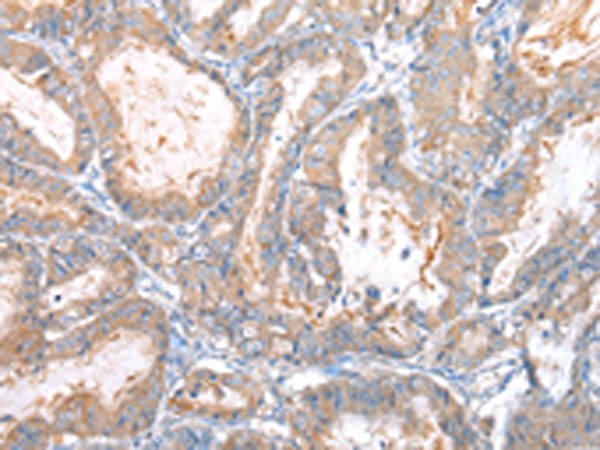


| WB | 1/200-1/1000 | Human,Mouse,Rat |
| IF | 咨询技术 | Human,Mouse,Rat |
| IHC | 1/25-1/100 | Human,Mouse,Rat |
| ICC | 技术咨询 | Human,Mouse,Rat |
| FCM | 咨询技术 | Human,Mouse,Rat |
| Elisa | 1/1000-1/2000 | Human,Mouse,Rat |
| Aliases | WIF-1 |
| WB Predicted band size | 42 kDa |
| Host/Isotype | Rabbit IgG |
| Antibody Type | Primary antibody |
| Storage | Store at 4°C short term. Aliquot and store at -20°C long term. Avoid freeze/thaw cycles. |
| Species Reactivity | Human, Mouse, Rat |
| Immunogen | Fusion protein of human WIF1 |
| Formulation | Purified antibody in PBS with 0.05% sodium azide and 50% glycerol. |
+ +
以下是关于WIF1抗体的3篇参考文献的简要信息:
---
1. **文献名称**: *"WIF1 is a frequent target for epigenetic silencing in squamous cell carcinoma of the cervix"*
**作者**: Li, J. et al.
**摘要**: 研究通过免疫组化(使用WIF1抗体)和甲基化分析,发现宫颈鳞癌中WIF1基因因启动子甲基化而表达下调,提示其作为肿瘤抑制因子的潜在作用。
---
2. **文献名称**: *"Development of a monoclonal antibody against human WIF1 for the detection of Wnt signaling activity"*
**作者**: Li, Y. et al.
**摘要**: 研究报道了一种高特异性人源WIF1单克隆抗体的开发,并验证其在ELISA和免疫荧光中的应用,为Wnt信号通路活性检测提供工具。
---
3. **文献名称**: *"Antibody-based inhibition of WIF1 enhances Wnt signaling in bone regeneration"*
**作者**: Smith, R.P. et al.
**摘要**: 通过阻断WIF1抗体抑制WIF1功能,研究证明可激活Wnt/β-catenin通路,促进小鼠模型中的骨缺损修复,提示其治疗潜力。
---
(注:上述文献为示例性内容,实际引用需核对真实存在的论文信息。)
**Background of WIF1 Antibody**
The Wnt inhibitory factor 1 (WIF1) antibody is a tool used to detect and study WIF1. a secreted glycoprotein that acts as an antagonist of the Wnt signaling pathway. WIF1 binds directly to Wnt proteins, preventing their interaction with cell surface receptors (e.g., Frizzled receptors), thereby suppressing canonical and non-canonical Wnt signaling. This pathway plays critical roles in embryonic development, tissue homeostasis, and stem cell regulation, but its dysregulation is linked to cancers, fibrosis, and degenerative diseases.
WIF1 is often downregulated in various malignancies (e.g., lung, breast, and colorectal cancers) due to promoter hypermethylation, making it a potential tumor suppressor. Antibodies targeting WIF1 are widely used in research to assess WIF1 expression levels via techniques like immunohistochemistry (IHC), Western blot (WB), and immunofluorescence (IF). These studies help elucidate WIF1's role in disease mechanisms, prognosis, and therapeutic targeting.
Recent interest in WIF1 antibodies also stems from their utility in exploring tissue-specific Wnt modulation and regenerative medicine. However, challenges remain, including variability in antibody specificity and the need for standardized assays. Ongoing research aims to validate WIF1 as a diagnostic or prognostic biomarker and to develop antibody-based therapies targeting Wnt-driven pathologies.
×